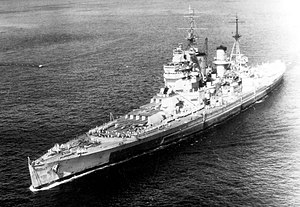HMS King George V (41)

HMS King George V enters Apra Harbour, Guam with sailors on deck in 1945
|
|
| History | |
|---|---|
|
|
|
| Name: | HMS King George V |
| Builder: | Vickers-Armstrong, Newcastle upon Tyne |
| Laid down: | 1 January 1937 |
| Launched: | 21 February 1939 |
| Commissioned: | 11 December 1940 |
| Decommissioned: | 1949 |
| Struck: | 1957 |
| Nickname(s): | KG5 |
| Fate: | Sold for scrap |
| Notes: | Pennant number 41 |
| General characteristics | |
| Class and type: | King George V-class battleship |
| Displacement: | 42,200 tons (1941) |
| Length: | 745 ft (227 m) |
| Beam: | 103 ft (31 m) |
| Draught: | 32.6 ft (9.9 m) |
| Propulsion: |
|
| Speed: | 28.0 knots (51.9 km/h) (1941 trials) |
| Range: | +5,400 nautical miles (10,000 km) at 18 knots (33 km/h) (11.9 tons/hour fuel burn) |
| Complement: | 1,314 to 1,631 |
| Armament: |
|
| Armour: |
|
| Aircraft carried: | 4 Supermarine Walrus seaplanes, 1 double-ended catapult |
HMS King George V (pennant number 41) was the lead ship of the five British King George V-class battleships of the Royal Navy. Laid down in 1937 and commissioned in 1940, King George V operated during the Second World War as part of the British Home and Pacific Fleets. In May 1941, along with HMS Rodney, King George V was involved in the hunt for and pursuit of the German battleship Bismarck , eventually inflicting severe damage which led to the German vessel sinking. On 1 May 1942 the destroyer HMS Punjabi sank after a collision with King George V in foggy conditions. King George V took part in Operation Husky (the allied landings in Sicily) and bombarded the island of Levanzo and the port of Trapani. She also escorted part of the surrendered Italian Fleet, which included the battleships Andrea Doria and Caio Duilio, to Malta. In 1945 King George V took part in operations against the Japanese in the Pacific.
Following the war, King George V spent three years as the flagship of the British Home Fleet, was placed in reserve in 1949, and scrapped eight years later.
King George V was built by Vickers-Armstrong at Walker Naval Yard, Newcastle upon Tyne; she was laid down on 1 January 1937, launched on 21 February 1939 and commissioned on 11 December 1940. The ship had an overall length of 745 ft (227 m), a beam of 112 ft (34 m) and a draught of 34 ft (10 m). She displaced 38,031 tons at normal load and 42,237 tons at full load. After her refit in 1944, she displaced 39,100 tonnes at standard load, and 44,460 tons at full load. She could carry 3,918 tons of fuel oil, 192 tons of diesel oil, 256 tons of reserve feed water and 444 tons of freshwater. Based on the designed fuel consumption, range was: 4,000 nautical miles (7,400 km) at 25 knots (46 km/h), 10,250 nautical miles (18,980 km) at 15 knots (28 km/h) and 14,400 nautical miles (26,700 km) at 10 knots (19 km/h). However, in practice fuel consumption was much higher, and at 16 knots (30 km/h) the actual range was about 6,300 nautical miles (11,700 km) with a five percent reserve allowance. Designed within the tight 35,000 ton limitations of the Washington Naval Treaty, wartime service necessitated increases over the design displacement, seriously reducing freeboard and affecting seaworthiness. This was most acute at the already low bow. With too little buoyancy forward the bows were easily buried even in moderate seas, with spray washing up over both forward turrets. Heavy seas could flood ‘A’ turret, drenching both men and machinery within.
...
Wikipedia
